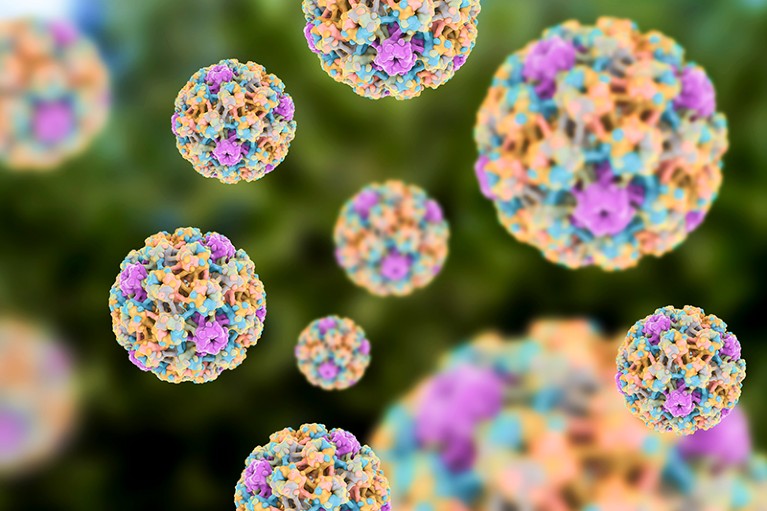
Credit: KATERYNA KON/SCIENCE PHOTO LIBRARY
Cancer prevention strategies are theoretically appealing although often difficult to implement, owing to the multifactorial pathogenesis of most cancers. The possibility of a notable exception first emerged in 1983, when Harald zur Hausen and others confirmed the presence of a specific human papillomavirus (HPV) subtype (HPV-16) in biopsy samples from several cohorts of patients with genital cancers.
Further research followed, and in 1999, HPV was confirmed as being not only present and involved in the aetiology, but also a necessary cause of virtually all cervical cancers. By that time, attempts to develop an HPV vaccine were already underway, and several technical hurdles had been overcome, including the availability of ‘virus-like particles’ (VLPs), which safely and efficiently induced infection-preventing antibody responses in animal studies.
Results from the first clinical trial of an HPV vaccine, involving a VLP-derived vaccine targeting HPV-16, were published in 2002. The efficacy results were deemed unequivocal by most experts: all 41 cases of persistent HPV-16 infections in a cohort of 2,392 18–23-year-old women were observed in the placebo group.
Another trial, by Harper et al., published in November 2004, provided the first evidence that HPV vaccination might reduce cervical cancer risk: Cervarix, a bivalent vaccine for HPVs 16 and 18, was found to reduce the risk of associated cervical abnormalities from 4.9% to 0.4%. A total of seven women had cervical intraepithelial neoplasia, including one in the vaccine group, who was later found to have a persistent HPV-51 infection. This experience highlighted the potential advantage of a vaccine covering a broader range of HPV subtypes.
Subsequent trials further confirmed the efficacy of HPV vaccination, including that with Gardasil, a quadrivalent vaccine targeting HPVs 6, 11, 16 and 18. Gardasil later became the first HPV vaccine to receive regulatory approval, by the US Food and Drug administration (FDA) in June 2006, for use in girls and women 9–26 years of age. A second approval followed, this time of Cervarix from the European Medicines Agency (EMA), which included vaccination for the prevention of anal cancer in males in the same age group. The FDA and EMA subsequently authorized Gardasil-9, which provides immunity against nine HPV strains, in 2014 and 2015, respectively.
HPV vaccination of males serves two purposes: vaccinated men are presumably less likely to transmit HPV to any sexual partners, and furthermore, vaccination is likely to confer some protection against other HPV-positive cancers, including those of the penis, oropharynx, oral cavity/larynx and anus. The latter possibility is supported by prospective data: Gardasil approximately halved the risk of grade 2 or 3 vaccine type HPV-related anal intraepithelial neoplasia in a cohort of men who have sex with men, a population known to have a particularly high risk of anal infections and cancers.
The long latency period between initial HPV infection and cervical cancer makes any reduction in cancer risk difficult to assess directly. Nonetheless, a registry study from Sweden, where HPV vaccines have been available since 2006, has revealed that the incidence of invasive cervical cancer among vaccinated women was approximately half that of nonvaccinated women. The incidence was 88% lower for those vaccinated below 17 years of age. Despite these apparent successes, the potential of HPV vaccination is only beginning to be realized. Many economically developed countries continue to lack universal HPV vaccination programmes, and vaccine availability is often limited to health centres, rather than schools and other community settings. Increasing public mistrust in vaccines might pose further challenges to implementation. Other challenges include the development of HPV vaccination programs for less economically developed countries, where cervical cancer is often the most common cause of cancer mortality. The emergence of generic HPV vaccines and the incidental finding that even single-dose vaccination provides some protection against HPV infection will hopefully enable wider implementation and might assist in addressing these challenges.

 Nature Milestones in Cancer: Interactive Timeline
Nature Milestones in Cancer: Interactive Timeline
 Efficacy of a bivalent L1 virus-like particle vaccine in prevention of infection with human papillomavirus types 16 and 18 in young women: a randomised controlled trial. (Harper, D. M. et al., 2004)
Efficacy of a bivalent L1 virus-like particle vaccine in prevention of infection with human papillomavirus types 16 and 18 in young women: a randomised controlled trial. (Harper, D. M. et al., 2004)